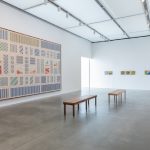Jordan Nassar’s solo exhibition—his first in Boston—presents a selection of his intricate embroidered and mixed media works. Nassar (b. 1985 in New York) draws on traditional Palestinian craft techniques to investigate ideas of home, land, and memory. His work, which he creates in collaboration with Palestinian embroiders and craftspersons, combines geometric patterns with abstracted landscapes, imbued, in the artist’s words, “with yearning, while hopeful and beautiful.” Through complex patterning and a unique attendance to form and color, the painterly aesthetic of Nassar’s embroidery allows the artist to explore relationships between craft and history in new contemporary dialogues.
Wall Text and Object Labels
Jordan Nassar (b. 1985 in New York) is a multidisciplinary Palestinian-American artist who works in traditional Palestinian craft. His embroideries, many of which he creates in collaboration with craftswomen in Ramallah, Hebron, and Bethlehem, combine regional motifs with imagined landscapes. A self-taught artist, Nassar is known for his use of Palestinian tatreez (a form of cross-stitch embroidery), through which colors, patterns, and designs distinguish a wearer both by their origins and their social or familial status, and can signal different stages of life. A thousands of years old tradition, tatreez has strong ties to Palestinian nostalgia, nationality, and heritage.
The two multipanel embroideries exhibited in this gallery, his largest to date, each contain fifty-seven individual panels. The titles — Song of the Flowers (2022) and Lament of the Field (2022) — are pulled from A Tear and A Smile (1914) by Lebanese-American writer Gibran Khalil Gibran (1883–1931), from which the title of this exhibition also draws. Gibran’s melancholic poetics address the ebb and flow of memory, time, and history; similarly, for Nassar, embroidery holds a tension between conflict and harmony in the relationship between stitch and thread, color and pattern. These painterly panoramas fuse complex patterning with close attention to form and color, and appear to exceed the boundaries of their frames to travel across the canvas and beyond it, suggestive of an expansive sky or a boundless horizon.
Throughout Nassar’s work, viewers encounter fragments of landscapes (an experience not unlike memories that fade over time and our collective efforts to recall them). In these imagined geographies, we find relationships that once were and could, perhaps, be again. “I like to discuss these landscapes as versions of Palestine as they exist in the minds of the diaspora, who have never been there and can never go there,” says the artist. “They are the Palestine I heard stories about growing up, half made of imagination. They are dreamlands and utopias that are colorful and fantastical — beautiful and romantic, but bittersweet.”
Nassar grew up with Palestinian tatreez (a form of cross-stitch embroidery) in his household. After exploring the medium in his artwork for several years, he was introduced to Palestinian embroiderers in the West Bank in 2017. He soon began making works with these women alongside his own embroidery practice. The collaborative works begin with sketched designs Nassar produces in a modular grid. He then sends his sketches to his collaborators in Palestine, who interpret the patterns according to different color schemes, leaving open sections for Nassar. He embeds his own original compositions to finish the embroideries in an act of co-creation.
In recent years, Nassar began working in traditional Palestinian glasswork techniques as well as inlay woodcrafts. To make the glassworks in this gallery, the artist arranged glass beads, which he hand-flamed, onto a steel armature similar to decorative latticework, drawing on techniques of the glass factories of Hebron, a practice dating back thousands of years. In the wood pieces also on display, Nassar creates new sedimented topographies through the layering of natural grains with hand-inlaid brass and mother of pearl; these materials recur in the artist-made benches in this gallery.
Press release from ICA Boston.



